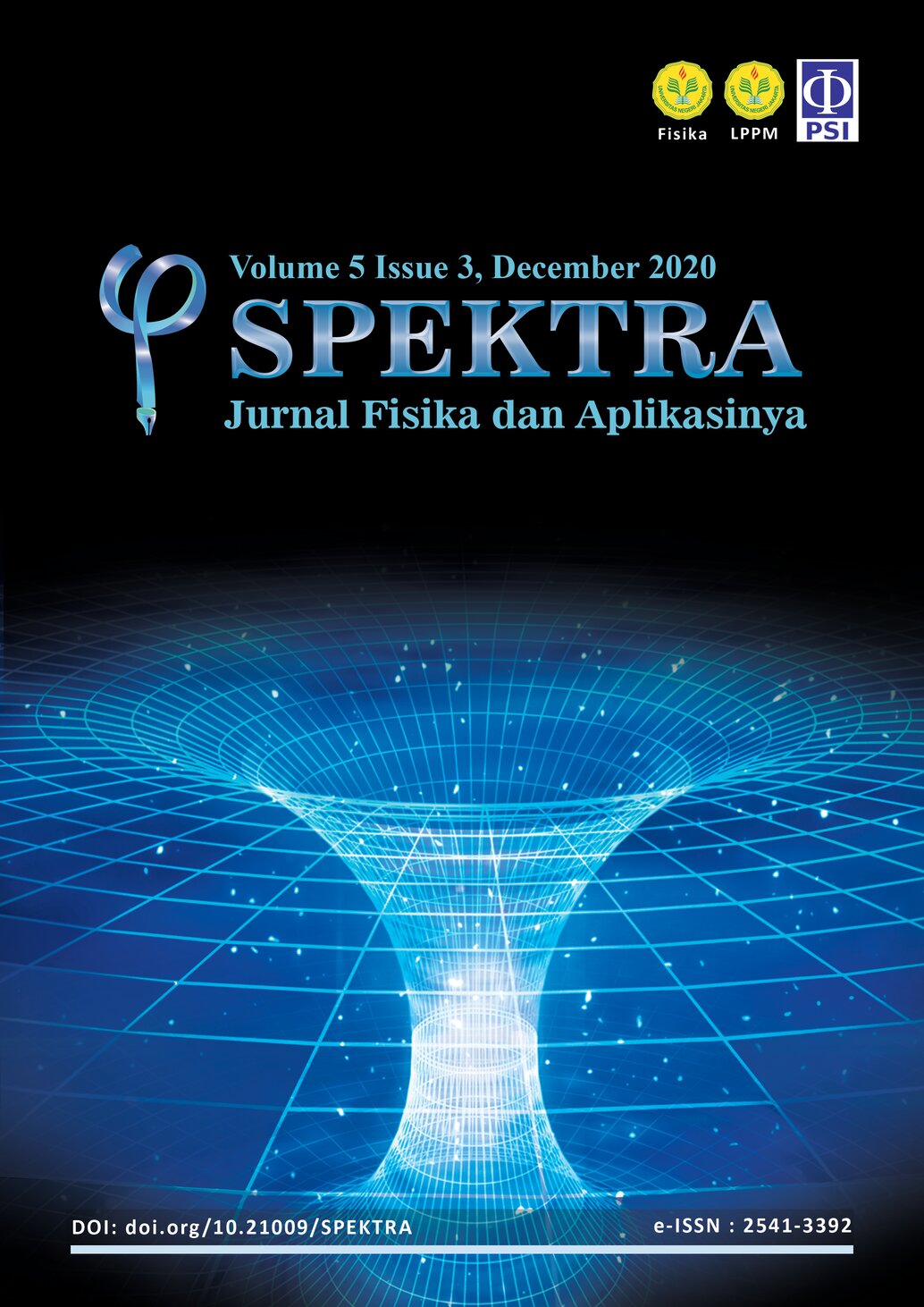THE CHANGE OF ROCK CONDITION OBSERVED BY H/V SPECTRAL AND ELLIPTICITY CURVE INVERSION ANALYSIS (CASE STUDY: PALU EARTHQUAKE SEPTEMBER 28, 2018)
DOI:
https://doi.org/10.21009/SPEKTRA.053.04Keywords:
palu earthquake, microtremor, HVSR method, seismic vulnerability, Vs30Abstract
Palu City is composed of sedimentary rocks so that it has a high level of vulnerability when an earthquake occurs. The earthquake that occurred on September 28, 2018, 25 km north of Donggala with a magnitude of 7.4 Mw, had caused a tsunami that struck Palu City, Sigi Regency, Donggala Regency, and Parigi Mouthong Regency, Central Sulawesi Province. This earthquake also caused liquefactions in the Petobo and Balaroa areas, Palu City, and Jono Oge in Sigi Regency. In this study, the authors used microtremor data at 8 points measured before and after the earthquake. Processing using the Horizontal to Vertical Spectra Ratio method shows that the predominant frequency and amplification factor changes due to changes in local rock conditions. The analysis also shows the value of soil vulnerability index (Kg) mostly increased after the earthquake. Besides, the elliptic curve inversion method shows that before the earthquake event, the value of the S wave velocity (Vs30) in layer one was between 157.1-211.4 m/sec with a layer thickness between 65.3-90.6 meters, while after the earthquake, the velocity becomes 156-214.6 m/sec with a layer thickness ranging between 66-99.2 meters. This indicates that the area consists of soft and medium soils, which subsequently increased sediment thickness in most areas after the earthquake.
References
[2] A. Soehaimi et al., “Peta Zonasi Kerentanan Bencana Gempabumi Daerah Palu dan Sekitarnya,” Bandung, Indonesia: Pusat Penelitian dan Pengembangan, Badan Geologi, 2000.
[3] I. Meilano et al., “Tektonik Geodesi Indonesia,” in Peta Sumber dan Bahaya Gempa Indonesia Tahun 2017, Tim Pusat Studi Gempa Nasional, Ed. Bandung, Indonesia: Pusat Penelitian dan Pengembangan Perumahan dan Permukiman, Badan Penelitian dan Pengembangan, Kementerian Pekerjaan Umum dan Perumahan Rakyat, pp. 119-191, 2017.
[4] W. F. Marcuson, “Definition of Terms Related to Liquefaction,” in Journal of The Geotechnical Engineering Division, vol. 104, no. 9, pp. 1197-1200, 1978.
[5] W. Hermawan et al., “Sebaran Kerusakan Geologi Permukaan,” in Di Balik Pesona Palu, Bencana Melanda, Geologi Menata, A. W. Kusumah M. et al., Ed. Bandung, Indonesia: Badan Geologi, Kementerian Energi dan Sumber Daya Mineral, pp. 101-111, 2018.
[6] J. Almendros et al., “Microtremor Analyses at Teide Volcano (Canary Island, Spain): Assessment of Natural Frequencies of Vibration Using Time-dependent Horizontal-to-vertical Spectral Ratios,” in Pure and Applied Geophysics, vol. 161, pp. 1579-1596, 2004.
[7] Badan Informasi Geospasial. (2018). Pusat Pengelolaan dan Penyebarluasan Informasi Geospasial Badan Informasi Geospasial (BIG). Peta Terdampak Gempabumi dan Tsunami [Online]. Available: https://tanahair.indonesia.go.id/portal-web/bencana/metadata_sulteng.html
[8] Y. Nakamura, “A Method for Dynamic Characteristics Estimation of Subsurface using Microtremor on the Ground Surface,” in Quarterly Report of RTRI, Vol. 30, no. 1, pp. 25-33, 1989.
[9] C. Acerra, H. B. Havenith, and S. Zacharopoulos, “Guidelines for the Implementation of the H/V Spectral Ratio Technique on Ambient Vibration: Measurement, Processing and Interpretation,” SESAME European research project, European Commission-Research General Directorate, 2004.
[10] N. Haerudin et al., “Earthquake Disaster Mitigation Mapping by Modeling of Land Layer and Site Effect Zone in The Kota Baru of South Lampung,” in Jurnal Pendidikan Al Biruni, Vol. 1, no. 8, 2019.
[11] Y. Nakamura et al., “Local Site Effect of Kobe Based On Microtremor Measurement,” in Proceedings of the Sixth International Conference on Seismic Zonation (6 ISCZ) EERI, California, 2000.
[12] H. C. Huang and Y. S. Tseng, “Characteristics of soil liquefaction using H/V of microtremors in Yuan-Lin Area, Taiwan,” in TAO, Vol. 13, no. 3, pp. 325-338, 2002.
[13] A. Omang et al., “Menghitung Guncangan Gempabumi” in Di Balik Pesona Palu, Bencana Melanda, Geologi Menata, A. W. Kusumah M. et al, Ed. Bandung, Indonesia: Badan Geologi, Kementerian Energi dan Sumber Daya Mineral, pp 57-70, 2018.
[14] A. Cipta and A. Solikhin, “Pendugaan Kecepatan Gelombang Permukaan (VS30) di Pulau Sulawesi Berdasarkan Klasifikasi Geomorfologi dan Aplikasinya,” in Jurnal Gunung api dan Mitigasi Bencana Geologi, vol. 3, no. 2, 2011.
Downloads
Published
How to Cite
Issue
Section
License
SPEKTRA: Jurnal Fisika dan Aplikasinya allow the author(s) to hold the copyright without restrictions and allow the author(s) to retain publishing rights without restrictions. SPEKTRA: Jurnal Fisika dan Aplikasinya CC-BY or an equivalent license as the optimal license for the publication, distribution, use, and reuse of scholarly work. In developing strategy and setting priorities, SPEKTRA: Jurnal Fisika dan Aplikasinya recognize that free access is better than priced access, libre access is better than free access, and libre under CC-BY or the equivalent is better than libre under more restrictive open licenses. We should achieve what we can when we can. We should not delay achieving free in order to achieve libre, and we should not stop with free when we can achieve libre.
 SPEKTRA: Jurnal Fisika dan Aplikasinya is licensed under a Creative Commons Attribution 4.0 International License.
SPEKTRA: Jurnal Fisika dan Aplikasinya is licensed under a Creative Commons Attribution 4.0 International License.
You are free to:
Share - copy and redistribute the material in any medium or format
Adapt - remix, transform, and build upon the material for any purpose, even commercially.
The licensor cannot revoke these freedoms as long as you follow the license terms.

 E-ISSN 2541-3392
E-ISSN 2541-3392  Focus & Scope
Focus & Scope  Editorial Team
Editorial Team  Reviewer Team
Reviewer Team  Author Guidelines
Author Guidelines  Article Template
Article Template  Author Fee
Author Fee  Publication Ethics
Publication Ethics  Plagiarism Policy
Plagiarism Policy  Open Access Policy
Open Access Policy  Peer Review Process
Peer Review Process  Retraction & Correction
Retraction & Correction  Licensing & Copyright
Licensing & Copyright  Archiving & Repository
Archiving & Repository  Contact
Contact  Mendeley
Mendeley 

